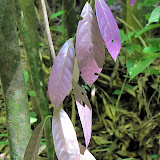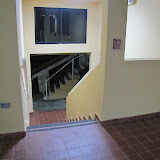 |
| Casco viejo |
31 days in Panama + 2010-11 school year tropical ecology unit
Sunday, June 27, 2010
Friday, June 25, 2010
Science in the tropical forest!
Today we joined Stephan Schneitzer, 2 of his post doctoral researchers, and two undergrad students; Liz and Dathan, in the tropical forest to do some real rainforest science! Stefan Schneitzer is currently researching the maintenance of species diversity.
One model he uses to study the maintenance of biodiversity is lianas. A liana is a woody vine so this encompasses many different species of vines. These lianas sometimes take over the trees in which they climb. In many instances their growth rises to the forest canopy and
encompasses many different species of vines. These lianas sometimes take over the trees in which they climb. In many instances their growth rises to the forest canopy and
As we walked to the central plateu where we recorded our observations we saw many interesting things along the way!
One model he uses to study the maintenance of biodiversity is lianas. A liana is a woody vine so this
 encompasses many different species of vines. These lianas sometimes take over the trees in which they climb. In many instances their growth rises to the forest canopy and
encompasses many different species of vines. These lianas sometimes take over the trees in which they climb. In many instances their growth rises to the forest canopy andsometimes dominates the tree canopy. Today we recorded on a scale 0-4 how much of a particular tree's canopy the liana (if present) was taking up. 0; no liana coverage, 1;0-25% liana coverage, 2;25-50% liana coverage, 3; 50-75
% liana coverage; 4; 75%-100%. After recording this for 4 hours we headed back and compiled our data to check
for reliability and consistency between observers (us). Surprisingly, our ratings were very similiar in all instances.
As we walked to the central plateu where we recorded our observations we saw many interesting things along the way!
Dana and Sarah standing in front of a huge Ceiba tree. It is one of the largest trees in the tropical forest.
The picture of the tree with many roots above ground is the "walking palm."

There are theories as to why the roots grow like this. One is that its root structure is an adaptation that allows it to "walk" a little to maximize exposure to sunlight. Another is that this provides opportunity for seedlings to grow around fallen trees and limbs.
The picture of the small fearless monkey staring down at us is a Howler monkey. These monkeys stay in large groups in the canopy and make spooky howling noises that wake us every morning.

Click below to see more photos of our hike - including an ameiva lizard...
 |
| 50 ha plot |
Thursday, June 24, 2010
Firsts and more firsts. . .
 It was a rainy first morning on Barro Colorado Island, but it cleared up by breakfast time. The sun was out for the rest of the day and we took a welcome walk into the jungle to get our boots wet. It was hot and humid, as you may have guessed.
It was a rainy first morning on Barro Colorado Island, but it cleared up by breakfast time. The sun was out for the rest of the day and we took a welcome walk into the jungle to get our boots wet. It was hot and humid, as you may have guessed.
Some of the first wildlife we saw were agoutis, pavo de monte, golden orb weavers,
a bullet ant nest called (Can you guess why it's named "bullet" ant?), beefsteak flower, leafcutter ants, and yes, we even saw a crocodile!
It was swimming across the now-forbidden-to-swim-in lagoon. We also saw heliconia, poison dart frogs, a ceiba tree (also known as a kapok tree. We have heard but not yet seen howler monkeys. Their call is low and loud.


 Today was our first trip into Gamboa. Gamboa was built for canal workers in the early 1900s. This house was for the Canal Director or some important person.
Today was our first trip into Gamboa. Gamboa was built for canal workers in the early 1900s. This house was for the Canal Director or some important person.We made our first trip into Panama City.
 Our first stop was at the Smithsonian Institute to get ID badges.
Our first stop was at the Smithsonian Institute to get ID badges.Our first meal in Panama City was at Stefan's favorite pizza place.

We didn't have much time in the city, but we did get our first feel for it. It seems very culturally diverse. We can't wait to get back in for some real exploring!

Subscribe to:
Posts (Atom)
